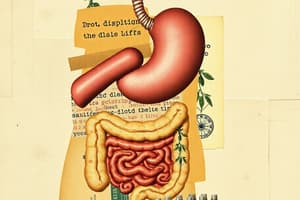Podcast
Questions and Answers
What is the primary function of peristalsis in the digestive system?
What is the primary function of peristalsis in the digestive system?
- Moving food through the digestive tract (correct)
- Absorption of nutrients
- Storing feces
- Breaking down food chemically
Which of the following processes specifically involves the action of chewing?
Which of the following processes specifically involves the action of chewing?
- Egestion
- Mechanical digestion (correct)
- Chemical digestion
- Absorption
What role do capillaries play in the digestive system?
What role do capillaries play in the digestive system?
- They increase surface area for absorption
- They produce enzymes for chemical digestion
- They facilitate nutrient absorption into the bloodstream (correct)
- They absorb fats
What is the function of hydrochloric acid in the stomach?
What is the function of hydrochloric acid in the stomach?
Which of the following statements about villi is correct?
Which of the following statements about villi is correct?
What type of digestion is primarily occurring when saliva moistens food?
What type of digestion is primarily occurring when saliva moistens food?
What is the main purpose of the large intestine?
What is the main purpose of the large intestine?
Which type of teeth is primarily responsible for grinding food?
Which type of teeth is primarily responsible for grinding food?
What is the primary function of the liver in the digestive system?
What is the primary function of the liver in the digestive system?
During inhalation, what happens to the diaphragm?
During inhalation, what happens to the diaphragm?
What is the role of cilia in the respiratory system?
What is the role of cilia in the respiratory system?
Which of the following structures stores bile produced by the liver?
Which of the following structures stores bile produced by the liver?
What happens to the thoracic cavity during exhalation?
What happens to the thoracic cavity during exhalation?
What is the main function of the pancreas in the digestive system?
What is the main function of the pancreas in the digestive system?
During external respiration, what occurs with oxygen and carbon dioxide?
During external respiration, what occurs with oxygen and carbon dioxide?
What is the function of mucus in the respiratory system?
What is the function of mucus in the respiratory system?
Flashcards are hidden until you start studying
Study Notes
Digestive System
- Ingestion: Taking food into the body.
- Digestion: Breaking down food.
- Absorption: Taking in nutrients from food.
- Egestion: Eliminating waste.
Digestive Tract
- Peristalsis: Rhythmic contractions in the digestive system that move food.
- Sphincters: Rings of muscles that control the movement of food and prevent backflow.
Digestion Types
- Mechanical: Physical breakdown of food.
- Chewing: Incisors cut, canines tear/rip, molars grind.
- Tongue: Moves food.
- Emulsification: Saliva lubricates and hydrates food.
- Chemical: Breakdown of food by enzymes.
- Enzymes are produced by glands.
Absorption
- Lacteals: Absorb fats.
- Villi: Increase surface area for absorption.
- Capillaries: Surround villi to absorb nutrients.
- Small Intestine: Villi are located here.
Mouth Digestion
- Physical: Chewing with teeth.
- Chemical: Saliva moistens food and contains amylase, an enzyme that breaks down starch.
Stomach Digestion
- Physical: Storage and mixing of food.
- Chemical:
- Hydrochloric Acid: Breaks down tissue and kills bacteria.
- Gastric Fluids: 2 liters released daily by stomach lining.
- Mucus: Protects stomach lining from acid.
- Pepsin: Enzyme that begins protein digestion.
Large Intestine
- Concentrates waste by absorbing water.
- Stores feces (undigested/unabsorbed material, water, and bacteria).
- Bacteria produce vitamins.
Additional Notes & Facts
- Pharynx: Tube that directs air to the trachea/lungs or food to the esophagus.
- Liver:
- Produces bile, an enzyme that helps break down fats in the small intestine.
- Functions as the body's chemical factory.
- Gallbladder: Stores bile produced by the liver; releases it into the small intestine when needed.
- Pancreas: Produces enzymes for breaking down fats, starches, and sugars. Also produces hormones for digestion.
- Rectum: Stores waste.
- Anus: Sphincter that pushes waste out.
Respiratory System
- Summary: Takes in oxygen for energy and expels carbon dioxide.
Inhalation Order (Breathing - Ventilation)
- Nasal cavity or mouth.
- Pharynx.
- Larynx.
- Trachea.
- Bronchi.
- Bronchioles.
- Alveoli.
Exhalation Order
- Reverse of inhalation order
Inhalation Functions
- Diaphragm: Contracts (flattens and moves down).
- Intercostal Muscles: Contract, moving rib cage up and out.
- Thoracic Cavity: Enlarges.
- Lung Pressure: Decreases, air rushes in.
Exhalation Functions
- Diaphragm: Relaxes and moves up.
- Intercostal Muscles: Relax, moving rib cage down and in.
- Thoracic Cavity: Decreases in volume.
- Lung Pressure: Increases, air is forced out.
Air Processing
- Cilia: Small hairs in the nasal cavity and airways.
- Sweep debris and mucus up the trachea to be coughed, swallowed, or spit out.
- Mucus: Coats cilia and lung tissue.
- Traps dust and bacteria.
- Allows gases to dissolve for movement through membranes.
- Blood Vessels: Warm air to body temperature.
Gas Exchange
- External Respiration: Oxygen diffuses from alveoli into blood.
- Hemoglobin: Oxygen binds to hemoglobin in red blood cells for transport.
- Carbon Dioxide: Diffuses from blood into alveoli.
Studying That Suits You
Use AI to generate personalized quizzes and flashcards to suit your learning preferences.




